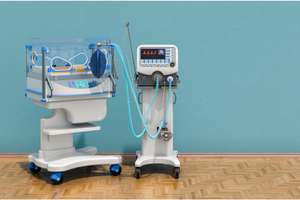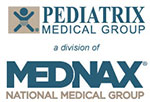Feature
Bilious Emesis in the Neonate

By Taryn M. Edwards, MSN CRNP NNP-BC
Intestinal obstructions are the most common surgical diagnoses in the neonatal period.1,2 It is imperative that an early and accurate diagnosis is made to ensure prompt patient management. In a neonate, bilious emesis can be the presenting sign of an intestinal obstruction and if not managed in a timely manner, some of these obstructions may result in intestinal compromise. An observational study found that neonates with bilious emesis were later diagnosed with an intestinal obstruction when abdominal distention, abdominal tenderness, and abnormal x-ray findings were present at the same time.3
In addition to abdominal radiographs, ultrasonography can play an important role in evaluating gastrointestinal disorders. Utilizing ultrasonography can diagnose or exclude midgut volvulus, a surgical emergency, by determining the location of the mesenteric vessels at their origin and following their course in the mesenteric root.4 Although ultrasonography can be utilized in this situation, an upper GI series remains the study of choice to diagnose malrotation with or without volvulus.5 Upon evaluation, contrast will leave the stomach and enter the duodenum. The duodenum will be to the right of the spine, the small intestine will all be on the right side of the abdomen, and the colon will be on the left. In a neonate with a volvulus you will see a “corkscrew” or ‘beaking” appearance of the duodenum and proximal jejunum.6,7
Neonatal intestinal obstructions can be divided into high and low obstructions. The table below delineates these diagnoses.2
- High intestinal obstruction
- Gastric atresia
- Duodenal atresia
- Duodenal stenosis with annular pancreas
- Duodenal web
- Malrotation
- Jejunal artesia
- Jejunal stenosis
- Gastric atresia
- Low intestinal obstruction
- Ileal atresia
- Meconium ileus
- Functional immaturity of the colon
- Hirschsprung disease
- Colonic atresia
- Anal atresia and anorectal malformations
General preoperative nursing considerations that should guide nursing care include gastrointestinal decompression, fluid and electrolyte balance, thermoregulation, prevention of infection, and nutrition.
Gastric Decompression
Gastric decompression is achieved via a nasal or oral gastric decompression tube that is connected to low continuous suction. Decompression is important to prevent aspiration, respiratory decompensation due to abdominal distention, or gastric perforation.8 Therefore, tube patency is essential to ensure decompression is maintained.
Fluid and electrolyte balance
The goal of nursing management in an infant with intestinal obstruction is to maintain fluid and electrolyte balance.8 It is critically important for strict and adequate intake and output measurements. The amount of gastric output needs to be measured every four hours to prevent fluid volume deficit and electrolyte derangement. Depending on the volume of gastric output, the volume may need to be replaced or the total fluid limit may need to be increased.8 Metabolic alkalosis may occur with high intestinal obstructions due to loss of acidic gastric secretions. In obstructions that occur in the distal segment of the small intestine, there are larger volumes of alkaline secretions are lost, therefore metabolic acidosis occurs.8 When the obstruction is below the proximal colon, acid-base balance is usually maintained since gastrointestinal fluids are absorbed before reaching the intestinal obstruction.8 Laboratory monitoring is essential to prevent acid-base imbalance and electrolyte derangements.
Thermoregulation
For any neonate, thermoregulation is vitally important. However, for the stressed or ill neonate, thermoregulation is even more critical. Cold stress dramatically increased oxygen consumption, predisposes the neonate to hypoglycemia and metabolic acidosis.8,9 Nursing interventions include external heat source, head covering, and temperature monitoring.
Prevention of infection
Surgical infants have an increased risk for infection, therefore broad-spectrum antibiotics should be administered immediately.8 Postoperative antibiotics will also be administered. Laboratory monitoring of complete blood count with differential in the preoperative and postoperative period will occur.
Nutrition
Caloric and metabolic demands of an infant with gastrointestinal dysfunction can be challenging. Since enteral feeding will be delayed parenteral hyperalimentation and fat emulsion will be utilized to provide nutrition and prevent catabolism while nil per os.8 Once the infant is ready for enteral feedings, a slow feeding advance will ensue. Advancement of feeding is followed closely to ensure tolerance. Intolerance includes diarrhea, vomiting, and abdominal distention.
General Postoperative Management
Hydration, maintenance of electrolyte balance, gastric decompression, and fluid loss replacement are continued in the postoperative period. Pain is assessed at least every four hours utilizing the appropriate pain assessment tool. Postoperative antibiotics will be administered; duration depends on surgical findings. Meticulous care is needed to maintain skin integrity due to possible limited positioning changes, opioid administration for pain management resulting in decreased active range of motion, and possible surgical drain placement.8
References
- Rainey S, Raji V, Bugaieski E. Newborn with bilious emesis and weight loss. Contemporary PEDS Journal. 2021; 35(9): 11-16.
- Vinocur DN, Lee EY, Eisenberg RL. Neonatal intestinal obstruction. Am J Roentgenol. 2012; 198(1): W1-10.
- Mohinuddin S, Sakhuja P, Bermundo B, et al. Outcomes of full-term infants with bilious vomiting: observational study of a retrieved cohort. Arch Dis Child. 2015; 100:14-17.
- Veyrac C, Baud C, Prodhomme O, et al. US assessment of neonatal bowel (necrotizing enterocolitis excluded). Pediatr Radiol. 2012; 42(S1): S107-114.
- Carroll AG, Kavanagh RG, Leidhin CN, et al. Comparative effectiveness of imaging modalities for the diagnosis of intestinal obstruction in neonates and infants. Acad Radiol. 2016; 23(5): 559-568.
- Luks FI. (2011). Fundamentals of Pediatric Surgery. P. Mattei (Ed.). New York, New York: Springer Science+Business Media, LLC.
- Applegate KE, Anderson JM, Klatte EC. Intestinal malrotation in children: a problem-solving approach to the upper gastrointestinal series. Radiographics. 2006; 26, 1485-1500.
- Kenner C & Lott JW. (2014). Comprehensive neonatal nursing: A physiologic perspective (5th ed.). St. Louis, MO: Saunders.
- Karlsen K. (2013). The S.T.A.B.L.E. program (6th ed.). American Academy of Pediatrics.
Our Sponsor


